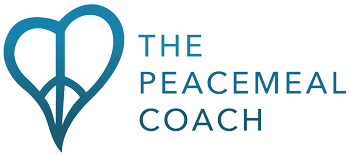I decided to call myself the peacemeal coach, and to design a peacemeal coaching program because of the experience I’ve had as a mom trying to get treatment for my anorexic daughter. My idea for peacemeal coaching came to me one day when I found myself describing the treatment approach to anorexia as piecemeal.
-
Merriam-Webster Dictionary defines piecemeal as “done, made or accomplished piece by piece or in a fragmentary way.”
-
The Oxford English Dictionary defines piecemeal as being “characterized by unsystematic partial measures over a period of time.”
-
Some synonyms for piecemeal include: gradual, partial, fragmentary, and intermittent.
I expected that once my daughter was diagnosed with anorexia that there would be a definitive and straight path to and through treatment so she could recover and get back to living her life. I thought it would take some time and effort, but if she followed the recommended medical guidelines, that she would be fine. I soon realized that there is no clear path; there is no straight path; there is no short path; and there is no proven path that is agreed upon to get from anorexia to recovery. In general, there are old models of treatment, new models of treatment, new research, and many “eating disorder” specialists who are designated as experts, but no consistently effective and available treatment method. Specifically, as in our case, the number of local professionals with training and experience treating eating disorders is limited.
We had to piece a “treatment team” together. We started with her pediatrician who had no experience with anorexia, but who was willing to study and learn what tests needed to be done, and how to monitor her weight, lab results, and vital signs regularly. We then added a psychologist from another state for parent support to guide us as we began to “refeed” our daughter. We had email contact with the psychologist for one month, access to her video program about refeeding your anorexic child, and one private phone call. We basically got some information and a little guidance, and then we were on our own. Next, we added a therapist and registered dietician from yet another state. My daughter had weekly video calls with them, and we put them in touch with her pediatrician so that they could coordinate my daughter’s care.
At this point, I was not feeling confident about the treatment I had so far been able to find. Every step of the way, I found myself thinking that a peacemeal approach would be so much more effective than the piecemeal approach we had followed so far. The treatment team that we had pieced together wasn’t working, and the reasons why motivated me to create a coaching program to support parents through the process of figuring out how to get their daughter to eat, while at the same time, figuring out how to get her the best treatment.
In our case, the first medical professional we turned to was not trained to treat eating disorders, but she was able to quickly see our daughter and assess her medical stability. Thankfully she was willing to immediately learn about anorexia so that she could order the appropriate tests and monitor my daughter’s progress. Because she wasn’t experienced with anorexic behaviors and the disordered thinking that my daughter was experiencing, I had to teach the pediatrician how to talk to my daughter, and about what was appropriate to share and not to share with her.
Instead of feeling like I could trust that the doctor would know what to do and what to say, I had to direct her to do what I had learned through the research that I had done about anorexia treatment. For example, her weight should be noted in the chart without the doctor reacting positively or negatively to it. At one visit, when my daughter had a significant weight gain, the pediatrician expressed how happy she was, how the number on the scale was so good, how great my daughter was looking, and how “full” her face was. She didn’t understand that my daughter, because of the anorexia, understood all of her positive feedback to mean that she was fat.
Needless to say, after weeks of eating without resistance, my daughter went back to refusing to eat, to negotiating what and how much to eat, and to crying whenever food was placed in front of her. It was almost like starting over again, and I had to tell the pediatrician that her reaction was not helpful to my daughter’s recovery.
Although I explained to the therapist and registered dietician that my husband and I were following FBT (family based treatment) guidelines to refeed our daughter, they counseled my daughter to do things outside of what we had established. For example, either I or my husband prepared and plated every meal and snack and served it to my daughter. She was not allowed in the kitchen for food preparation, and she did not have a choice as to what or how much she was expected to eat. She was expected to eat whatever we gave her, and we reinforced to her that we knew what she needed, that she could trust us, and that food was her medicine.
Because anorexics do not usually recognize that they are sick, and they don’t always have a desire to change or recover, it is important for parents to temporarily take control of eating decisions. In the beginning, she had no awareness of hunger cues; she just needed to eat. Even though the registered dietician had been treating eating disorders for about twenty years, she counseled my daughter to eat intuitively, to eat when she was hungry, and to stop eating when she was satisfied. At that time, she was hypermetabolic and needing 3500 calories a day to even gain a small amount of weight weekly.
Similarly, her therapist was working with her on becoming more independent from her parents at a time when it was crucial for her to depend on us to eat, and she was in no condition to start making her own decisions. We wanted to get help for our daughter, but we realized that her expert therapist and dietician were actually working against the progress we had made with her eating.
So, my husband and I had chosen to take primary responsibility for refeeding our daughter in order to restore her weight, but we had assembled a team of professionals who were not trained in the model that we had chosen. Although I attempted to communicate everything that I had learned about the evidence-based anorexia treatment we wanted to follow, my daughter’s treatment team continued to give her mixed messages. As a result, she stopped working with the therapist and nutritionist, we continued feeding her, her pediatrician continued following her medical condition, and we started looking for new team members that could work with us to help her.
I define peacemeal , which is not a word you will find in a dictionary, as “done or accomplished by consistently applying an attitude of peace to each and every meal and snack.” Instead of piecing together treatment options hoping to find the ideal one, I decided to take a peacemeal approach and literally bring peace to our table at every meal and every snack. By applying the tools I learned as a life coach, I was able to manage my thoughts and emotions in order to create a peaceful atmosphere at the family table even when my daughter’s anorexic behaviors were at their worst.
Weight restoration, regardless of treatment choices, remains the central goal of anorexia recovery. By adopting a peacemeal approach to feeding my daughter 3 meals and 3 snacks a day, I was able to remain calm, compassionate, and strong while refeeding her, and I believe my confidence helped her to face her fears more readily than if I had been anxious, angry, and scared. Getting her to eat by peacefully addressing her anorexic behaviors has made it possible for her to gain weight, and has allowed time to carefully craft a treatment plan that is best for her recovery.
I created the Peacemeal Program for parents of teen anorexics to share the tools and techniques that I used to get my anorexic daughter to eat. If you would like more information on how you can bring peace to your table, please contact me at jenni@peacemealcoach.com for a free 20-minute mini coaching session.






